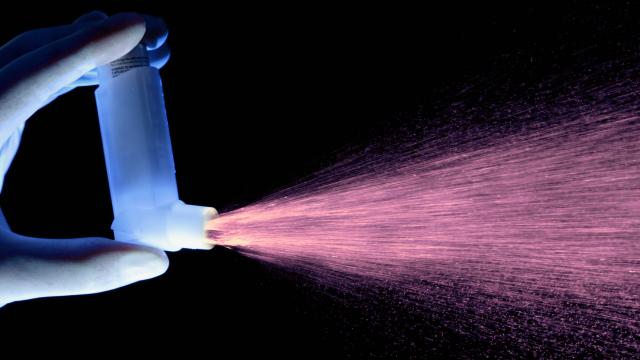Future vaccines might involve a deep breath rather than an injection, if technology detailed in research published Thursday pans out. The proof-of-concept study in mice and primates suggests that vaccines can be safely absorbed through the lungs into the bloodstream in order to do their job of training the immune system. The authors hope that their work could also someday be used to develop new inhalable therapies for asthma and other respiratory conditions.
The technology was developed by researchers at Rutgers University in New Jersey. It’s supposed to work by using phages: viruses that infect bacteria. Since phages only hunt their fellow microbes, they’re not inherently harmful to people. In fact, phages have been used for decades as an alternative to antibiotics for their bacteria-killing ability, and the recent antibiotic resistance crisis has led to renewed interest in phage therapy.
Researchers are also exploring whether phages can be turned into new types of vaccines. Phages can be modified to display specific protein molecules on their surface, while the instructions for making these proteins can be nestled inside their genes, allowing them to be highly customisable. These phages can then enter human cells and deliver their payload, such an antigen that will train the immune system to recognise a threat like the coronavirus. But because phages don’t care about people, so to speak, they shouldn’t replicate inside cells like a real infection or cause other toxic effects. On top of that, phages are easy and cheap to mass-produce, can survive in harsh environments, and they don’t need extreme cold temperatures to be kept viable — a problem that continues to plague some vaccines, including the mRNA covid-19 vaccines recently developed by Pfizer, BioNTech, and Moderna.

This new research builds on the existing work being done with phage vaccines but adds a wrinkle. According to study author Wadih Arap, a cancer researcher at Rutgers, they’ve found a way to create a phage-based vaccine that’s aerosolised and safe to inhale. This was done by finding a specific molecule, or ligand, that interacts with an important receptor found on lung cells and attaching it to the phages. This key should allow the phages to glide past the lungs and reach the bloodstream, where the phages would carry out their task of immunizing the body to whatever germ scientists want to target.
In experiments with mice and non-human primates, Arap and his team’s vaccine was able to cross the lung-bloodstream barrier intact, while not appearing to cause any changes to the lungs’ normal function. Once there, the vaccine then provoked a robust immune response from the body to the phages and the proteins they carried, which is exactly what they wanted to see. The findings were published Thursday in the journal Med.
Scientists have worked on trying to create inhalable vaccines for years now. Not only would they be more convenient and less painful than getting a shot or even spraying something up your nose, they might also be faster-acting with fewer side effects. But according to Arap, one limitation to their development is that there’s still a lot unknown about how our lungs really work, including exactly how substances are absorbed through the lungs into the rest of the body. One grander part of their work is the hope that they’ve come closer to unravelling this mystery, which should allow their technology to extend beyond breathable vaccines. Ultimately, it’s possible that this could be used to deliver medicines for asthma, cystic fibrosis, and other respiratory illnesses.
“Targeted pulmonary vaccination is only one of the many potential applications of ligand-directed pulmonary delivery,” Arap said in an email to Gizmodo. “Aerosol formulations could also involve drug or imaging agent delivery to the lungs.”
This research is still preliminary, of course. But the team is already working on larger animal trials, as well as adapting their technique to be used against the SARS-CoV-2 coronavirus. Even if this vaccine technology doesn’t see any action during the current pandemic, it may yet play an important role in the future. After all, it wasn’t so long ago that mRNA vaccines — now the first approved covid-19 vaccines in the world — were just the stuff of basic research.
